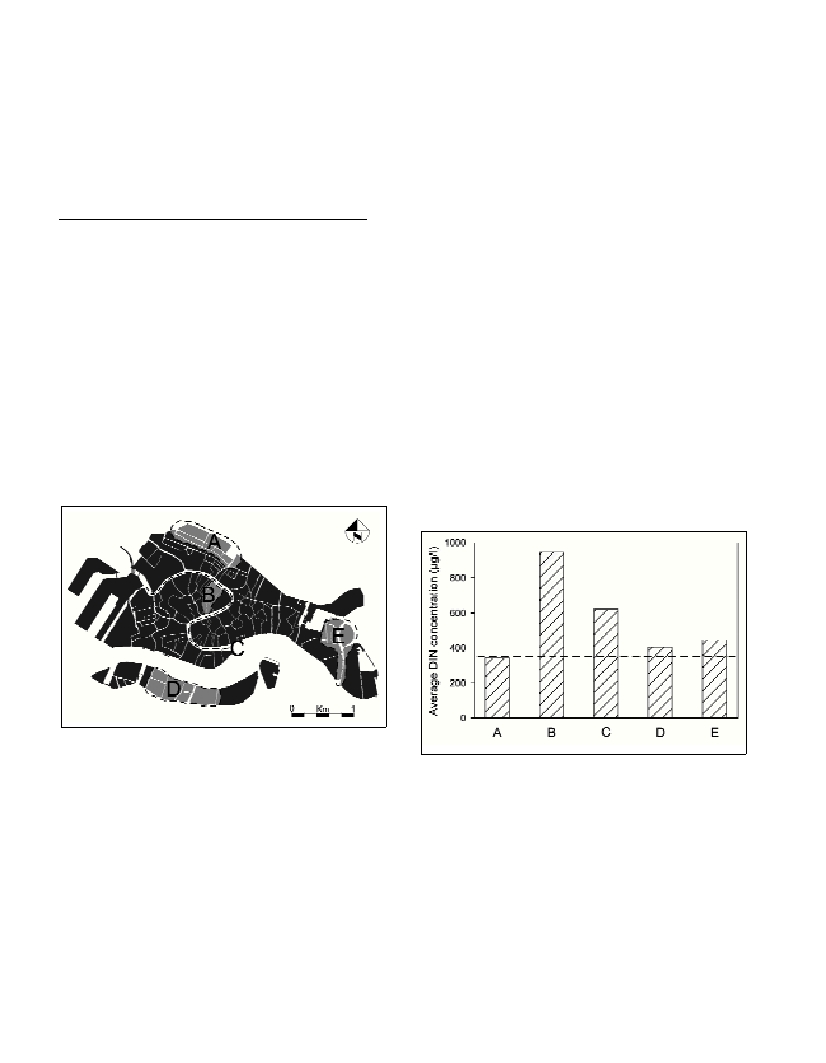Rapp. Comm. int. Mer Médit., 37,2004
255
WATER QUALITY OF THE VENICE CANAL NETWORK: RESULTS OF AN INTENSIVE MONITORING
R.Zonta
1*
, M. Scattolin
2
, M. Botter
1
, F. Collavini
1
1
National Research Council – Institute of Marine Science. San Polo, 1364 – 30125 Venice, Italy *roberto.zonta@ismar.cnr.it
2
Venice City Council – Environment Department. San Marco, 4136 – 30124 Venice, Italy
Abstract
An intensive monitoring activity was performed in spring 2003, to ascertain the water quality of five different zones of the Venice canals
network. In consequence of the recent dredging interventions and realisation of sewage purification systems, the results testified acceptable
quality conditions in the monitored canals. Further investigations are needed in order to highlight the presence of specific sources, which
determine a decrease of the water quality, and to establish suitable methodologies for the future control of the canals network.
Keywords: water quality, pollution, urban wastewater, Venice
In recent years, a series of maintenance and restoration
interventions has been started in the about 40 Km-long Venice canals
network. They include both the removal of a thick layer of
contaminated sediment resulting from more than 30 years of
sedimentation, and the reduction of the amount of domestic and
commercial wastewaters. As a consequence, a progressive
improvement of the water quality in the network is expected, which
must be ascertained by means of specific water samplings and
analyses. However, due to the complexity and variable characteristics
of the network, suitable methodologies for the evaluation of the
present situation and the control of the water quality in the future are
still to be defined. Different factors induce temporal variability of the
water quality in a given site: level variation in different tide phases;
meteorological conditions; the strewn wastewater effluents; bottom
sediment resuspension due to shear stress and boat traffic; the ?ow of
water masses coming from neighbouring parts of the network. In this
picture, an intensive monitoring activity was performed in 28 stations
belonging to five different zones of the City (Fig. 1): three marginal
areas located in the North (A), South (D) and East (E) respectively, a
inner area (B), and the Canal Grande (C), through which a large part
of the canals network is fed and drained by tidal currents.
Fig. 1. Map of the City of Venice. The investigated zones are evidenced.
Each station was monitored at least ten times in the period between
March 4
th
and April 16
th
2003, collecting more than 300 water
samples that were analysed for the following determinants: suspended
particulate matter; heavy metals (Fe, Mn, Cd, Cu, Pb, Zn); nitrogen
and phosphorous dissolved species; total and fecal coliforms; fecal
streptococcus. Samples were mainly collected around the minimum
tide, in order to account for the worst quality conditions occurring in
the water column. The water sampling was always accompanied by
the measurement of water dynamics and phisico-chemical parameters
(salinity, temperature, dissolved oxygen, turbidity, pH, redox
potential). Data clearly show differences in the quality conditions
among the investigated areas. Marginal areas (A, D, E) have a lower
contaminants and bacteria content and better physico-chemical
characteristics (higher dissolved oxygen concentrations and redox
potential values, lower turbidity) with respect to the inner area B. This
is ascribed to both a better water renewal and the effectiveness of the
interventions already realised in the three marginal areas. The water of
the Canal Grande shows intermediate characteristics with respect to
marginal and inner areas. Figure 2, for example, shows the average
concentrations of dissolved inorganic nitrogen (DIN) measured in the
five zones. It is worthwhile to observe that in the majority of the
stations belonging to the marginal areas DIN concentration is close to
- or even lower than - the imperative values (350
µ
g/l) established by
the Italian law for the water of the lagoon. This feature also holds for
dissolved phosphorous, whose imperative value is 25
µ
g/l.
Concentrations of Cu and Pb – as well as those of Fe and Mn -
measured in all the 28 stations are, with very few exceptions, lower
than the average values that characterise the freshwater discharged
into the Venice lagoon from its drainage basin. Zinc concentrations
are instead of the same order or even greater. Cadmium always
resulted lower than the detection limit (0.1 µg/l). Finally, coliforms
show levels lower than the EC imperative values for the bathing
waters (Directive 76/160/CEE) in the majority of the stations; the
concentration of fecal streptococchi is instead greater than the EC
limit. The investigation highlights an acceptable situation for the
water quality of the Venice canals network, which is probably better
than the expected one on the basis of the number of the planned
interventions already performed and the time elapsed. Anyway, the
high concentrations of some determinants systematically observed in
some of the 28 stations require further investigations, in order to
check the eventual presence of specific sources affecting the quality of
the water column.
Fig. 2. Average concentration of dissolved inorganic nitrogen in the five
zones. The dashed line corresponds to the Italian imperative value
(350
µ
g/l) for the lagoon.

